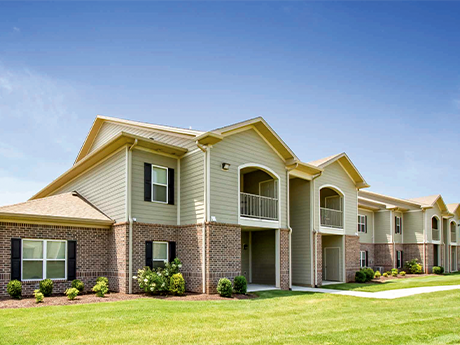Nothing can compare to the rent growth and investment activity of 2021 and early 2022. Most brokers active in the Southeast predict the first half of 2023 will be slower compared with the past several quarters, but the second half of the year could provide just enough clarity about interest rates to inspire buyers and sellers. A positive spring leasing season could fan the flames of pent-up demand from investors who, for now, will wait to make their next move.
Southeast Multifamily & Affordable Housing Business sent questionnaires via email to brokers active throughout the Southeast to learn more. Participants include: Ashish Cholia, vice president, CBRE, covering the Southeast; Jonathan Hawks, senior director of multifamily investment sales, Franklin Street, covering Tennessee, Kentucky and Alabama; Craig Hey, vice chair, Cushman & Wakefield Sunbelt Multifamily Advisory Group, covering the Southeast; Justin Hofford, associate vice president, investment sales, Northmarq, covering Florida; and Mike Kemether, executive vice chair, Cushman & Wakefield Sunbelt Multifamily Advisory Group, covering the Southeast.
Their edited responses follow.
Southeast Multifamily & Affordable Housing Business: What do you expect the biggest investment sales story to be in 2023? What was the biggest headline in 2022?

Cholia: After a frenzied start in 2022, transaction volume came to a grinding halt later in the year. The first half of the year was extremely active, with pricing breaking records on a regular basis. The market exuberance was driven by strong rent growth, which was approximately 15 to 20 percent year-over-year for the region, steadily declining cap rates and inexpensive short-term bridge financing.
In the second half of 2022, as the Fed started to aggressively raise interest rates to curb inflation, financing real estate transactions became very expensive. By the fourth quarter, interest rates on multifamily loans almost doubled from 10 months prior, and transaction volume plummeted.
If transaction volume in 2022 could be categorized as ‘front-end loaded,’ 2023 could likely be categorized as ‘back-end loaded’ this year. If the Fed stops raising interest rates in the third and fourth quarters of this year as expected — and possibly starts to lower them — multifamily housing’s strong macro fundamentals will bring investors back into the market.

Hawks: The big story in 2023 will be how investors adjust to the new market. One of the biggest challenges as a broker right now is managing seller expectations. Many owners are not in tune with the current market environment and are grappling with the fact that their properties aren’t worth what they were six to 12 months ago during the peak of the market.
With the rise in interest rates over the past year, among other factors, we are seeing fewer properties trade. However, as both buyers and sellers begin to become more comfortable with current market conditions, we can expect deal volume to steadily pick back up.
Hey: We hope that 2023 will be the year of stabilization and visibility after a volatile 2022. The biggest headline for us in 2022 was rising rates that effectively shut down bridge lending and slowed the market. As market participants see the light at the end of tunnel when it comes to interest rates, liquidity and confidence will grow throughout this year.
Hofford: The biggest headline in 2022, without question, was inflation and how the Fed aggressively spiked interest rates to combat it. The biggest investment sales story in 2023 will be the continuation of Fed policy maneuvers and the stabilization of interest rates. This ‘reset’ of interest rates will provide much needed clarity in the investment world, creating an environment of normalcy that should spur transaction volume.
Kemether: We see 2023 as a year where both market stability and deal volume will grow throughout the year. While 2022 was marked by rapidly increasing interest rates, causing some debt market instability, 2023 will provide more clarity and stability toward the end of the year.
SMAHB: The Federal Reserve indicated in December that it will continue to raise rates until inflation is significantly reduced. How will the Fed’s strategy affect the multifamily market in your territory in 2023?
Cholia: Compared with record-breaking sales transactions in 2021 and 2022, which nationally were $341 billion and $277 billion respectively, we likely will see a slowdown in 2023. Higher interest rates will make properties more expensive to finance, and inflation will likely slow rent growth. CBRE has seen transaction volume slow since the second half of 2022. This slowdown is expected to continue in the first half of 2023.
Hawks: We saw sales activity nearly come to a halt in the fourth quarter of 2022 after experiencing the fastest interest rate increase in history. Many investors sat on the sidelines during this time while waiting out the uncertainty. Although the Fed is expected to continue raising rates, the increases won’t be nearly as steep as last year. Now that investors have more clarity, we’re already beginning to see more deals in Nashville.
Hey: From what we are hearing, the next rate hike in February is effectively built into the debt market already. If spring leasing is positive, we feel that things will get back on track. The rising rate environment made it hard to keep offers at the same level throughout the marketing and contract period, even as the fundamentals of the underlying assets remained strong. Stability in the debt market, coupled with positive leasing trends this spring, should put our markets in a position where transaction velocity will pick back up. There is a lot of capital and pent-up demand for deal flow.

Hofford: Unfortunately, we anticipate several more interest rate hikes by the Fed. Depending on the degree of the rate hikes, the overcompensation from the Fed could possibly put us in an environment where rate reductions toward the second half of the year become possible. In the interim, we anticipate transaction velocity will continue to slow until interest rate stabilization occurs.
Kemether: Higher interest rates have an inverse impact on multifamily property values. One unique aspect of 2022 was the sheer number of interest rate increases, but this certainly doesn’t mean that transactions will come to a halt. There are still a lot of reasons for owners to sell. Debt assumptions become very interesting, funds come to a close and some owners see an opportunity to get a scarcity premium when there is a lack of product on the market.
SMAHB: How do cap rates in your region compare with national averages?
Cholia: Since the Fed started to increase interest rates in March 2022, multifamily cap rates have also increased. In most Southeast markets where rent growth is still robust, cap rates have not increased as much compared with markets with modest to no rent growth. Overall, cap rates in most major Southeast metros are still lower than the national average.
Hawks: The rise in interest rates has caused cap rates to increase, but it’s worth noting that multifamily cap rates in Nashville are still considerably low. Deals were closing in the mid-3 percent range during the height of the market last year. Today, we’re seeing deals closing around 4 percent to 5.25 percent, which is still below the national average.

Hey: Rate hikes have definitely driven up caps. We have not done an in-depth study of the national averages, but we’ve found that because we work in tertiary and secondary markets, our cap rates do trail the larger Southeast market to some degree. Many buyers have sought safety through a flight to quality, given the unpredictable bridge lending andmacroeconomic concerns. As these headwinds dissipate, cap rate compression will grow, especially for higher-yielding opportunities in more tertiary markets.
Kemether: Yes, our cap rates have grown in the Southeast, but they have not grown at the same rate as other regions of the country. This is due to the Southeast’s positive population growth, job growth, property operations growth and a continued investor capital commitment to the Southeast.
SMAHB: Have asset prices in your area increased, decreased or remained the same?
Cholia: Over the past 10 years, multifamily asset values have increased every year on a year-over-year basis. The rate of increase in 2021 and 2022 has been significantly higher than before 2020. In metro Atlanta, median per-unit sales prices increased by 22 percent between 2021 and 2022, which was 36 percent higher than in 2020. The increase in values is a result of double-digit NOI increases as well as significant cap rate compression. In most major markets in the Southeast, the supply of multifamily units has significantly increased, but high single-family home prices and mortgage rates will likely keep rental housing demand steady.
Hawks: Asset prices in Nashville began rising rapidly at the beginning of 2021 due to a number of factors, including investor demand and inflated construction costs. However, the Nashville market is experiencing a shift in supply and demand dynamics that, along with the increased cost of borrowing, will likely lead to a slowdown in per-unit pricing growth.
Here in Nashville, we currently have more than 22,000 multifamily units under construction, 10,000 of which are set to deliver before the end of the year. For comparison, in 2022, our market only had 8,000 units in the pipeline. The current vacancy rate in Nashville is around 6 percent, and with new deliveries pushing that rate higher, we can expect to see rent growth slow. Ultimately, this will lead to lower valuations than sellers were used to seeing last year, as we won’t be able to underwrite the same levels of projected rent growth.
However, Nashville still has a very healthy number of new jobs coming to the market that should help absorb the new inventory. Interest rates for single-family homes, which currently average around 7 percent, should also keep rental demand high.
Hey: Asset prices have grown over the past few years, but more recently they have fallen due to rising borrowing, insurance and construction costs. Strong and growing rents continue to bolster our space, and pricing will come back as the economy become more stable. Market confidence is key. People will underwrite higher debt and insurance costs if they feel volatility has passed.
Hofford: Asset pricing peaked at the end of 2021 and the beginning of 2022. Values are down since peak pricing. Fortunately, we have continued to see strong rent appreciation during this period, which has offset some of the cap rate escalations.
SMAHB: How are multifamily assets performing in your region?

Hey: For the first time since the beginning of the pandemic, we’re seeing real seasonality in most markets by way of a slow winter. We might be back to pre-pandemic trends, but we’re watching it unfold right now. A significant tailwind for our space will be higher mortgage rates for single-family borrowers. Existing home sales are down 35 percent year-over-year, which will continue to put upward pressure on apartment rents.
Hofford: Multifamily operating conditions in Tampa are generally favorable. Asking rents ticked lower in the past three months after posting some of the most rapid growth in the country for the previous six consecutive quarters. During the past 12 months, average rents have risen by 6.6 percent, or more than $110 per month. Vacancy rates continued to tighten, even as the pace of construction accelerated. The current vacancy rate is at its lowest point in more than five years.
Kemether: Asset performance has been very strong for a number of years now. Epic rent growth and historically high new lease trade-outs have taken the edge off tapering asset values caused by an increased interest rate environment. It’s important to note, though, that in early September 2022, these unprecedented rental-rate increases have tapered to more typical historic levels.
SMAHB: Which category of buyers in your territory has been the most active over the past year? Do you anticipate any changes on that front in 2023?
Cholia: In the multifamily space, private capital groups have been the most dominant buyers over the past 10 or more years, followed by institutional capital. In 2020 and 2021, about 55 percent of all transactions in metro Atlanta involved private capital. That number increased to 60 percent in 2022. We expect that in 2023, private capital will remain the dominant buyer type and could potentially exceed 60 percent in market share.
Hawks: Nashville remains a top market for investors of all kinds, but we expect REITs and private investors to remain most active in 2023. Investors who have cash to offset the cost of borrowing will find the most opportunity this year.
Hofford: Private capital/family offices have been the most active in the market. We anticipate institutional capital will accelerate its investments in Florida multifamily this year as it becomes clear the string of interest rate hikes by the Federal Reserve has peaked.
Kemether: Private investors and DSTs have led the charge in the Southeast in the past couple of years. This likely will continue throughout the first half of 2023. Institutions are sometimes slower to jump back into the water. They will want to watch what their peers are doing.
SMAHB: Are you seeing any trendlines regarding the type of apartment properties that are most frequently changing hands?
Cholia: In most years, value-add, garden-style apartments, typically built in the 1980s or 1990s, see the majority of investment activity mostly because value-add investors typically have shorter holding periods that last about three to five years. Last year was in line with historical averages. Moving forward, we don’t expect that to change meaningfully. Urban, high-rise properties are generally held by longer-term institutional owners for seven to 10 or more years, which results in fewer transactions of that product type.
Hawks: Over the past year, we have seen a shift in the product type investors are targeting in the Nashville market. For years, properties built in the ’60s, ’70s and ’80s were viewed as the most desirable value-add deals in the region. However, now that most of those properties have traded several times over, it’s difficult to make the value-add model work the way it once did. Instead, we’re seeing investors target properties built in the ’90s and early 2000s, which provide more value-add runway.
When it comes to property type, garden-style, workforce housing and light value-add assets are in the highest demand, while urban high-rise and luxury assets have a much smaller buyer pool today.
Kemether: We are seeing a migration to quality, which often happens when things become less stable. One space that has performed extremely well throughout the turbulence of the past year is the core-plus space. Really well-located, newish properties with a story and room to move rents have held up quite well over the past 12 months.
SMAHB: What will be the biggest challenge in your territory this year?
Cholia: Like many other metropolitan areas in the Sun Belt, the Atlanta MSA (metropolitan statistical area) has experienced significant population and job growth. Atlanta is also experiencing a fair amount of new multifamily supply with about 40,000 units projected to be added over the next three years. Rising interest rates and home values will likely curtail renters moving to home ownership, which will likely have a positive effect on the market.
Hawks: The increased cost of borrowing paired with a low inventory of properties for sale will create some challenges in Nashville this year, but as with any challenge, it will also lead to opportunity. To win, investors will need to bring more cash to the table and work with a team that looks at all sides of the deal, including property insurance.
Hofford: Interest rates and rising insurance costs are the hot -button issues we are hearing about the most.
Kemether: We are very bullish about the long-term prospects for multifamily in the Southeast for a host of reasons. Capital continues to build, and there still exists a national housing shortage, which is not easy to correct quickly. Sure, there will be challenges in some micro-locations due to supply issues or debt market challenges. But overall, we like the long-term prospects of multifamily in the Southeast.
— Compiled by Lynn Peisner, editor of Southeast Multifamily & Affordable Housing Business magazine


